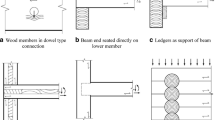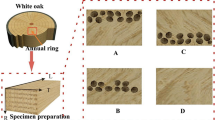Abstract
This study explored the feasibility of the finite element method (FEM) and Hankinson formula to predict the compressive properties of cross-grain wood with a wide range of moisture content, avoiding the waste of materials and time in experimental methods. This study examined the influence of moisture content and cross-grain orientation on the elastoplastic performance of beechwood under compressive loads. The comparison of compressive load–displacement curves between the experiment and FEM was achieved, and the relative errors of compressive yield strength or modulus of elasticity between the experiment and FEM. The stress concentration distribution and failure models of different principal planes were analyzed. It demonstrated that the FEM could simulate compressive elastoplastic properties of wood with 45º cross-grain and a broad range of moisture content. For cases of 45º cross-grain orientation, comparisons between the experimental data and FEM, and Hankinson formula, were conducted which validated that the Hankinson formula can predict beechwood’s compressive yield strength and elastic modulus with multilevel grain orientations and moisture contents. Regression models were established based on the Hankinson formula to forecast the compressive yield strength or modulus of elasticity for a broad range of moisture content and random grain direction. This study can assist in the rational utilization of cross-grain timber in terms of structural optimization of outdoor wood products.












Similar content being viewed by others
References
ASTM E104–02 (2012) Standard practice for maintaining constant relative humidity by means of aqueous solutions. ASTM, International, West Conshohocken
Aydin TY, Ozveren A (2019) Effects of moisture content on elastic constants of fir wood. Eur J Wood Prod 77:63–70. https://doi.org/10.1007/s00107-018-1363-3
Bachtiar EV, Sanabria SJ, Mittig JP et al (2017) Moisture-dependent elastic characteristics of walnut and cherry wood by means of mechanical and ultrasonic test incorporating three different ultrasound data evaluation techniques. Wood Sci Technol 51:47–67. https://doi.org/10.1007/s00226-016-0851-z
Burgert I, Bemasconi A, Niklas KJ et al (2001) The influence of rays on transverse elastic anisotropy in green wood of deciduous trees. Holzforschung 55:449–454. https://doi.org/10.1515/HF.2001.074
Chen ZY, Zhu EC, Pan JL (2011) Numerical simulation of mechanical behavior of wood under complex stress. Chin J Comput Mech 28(04):629–640 (In Chinese)
Fu WL, Guan HY, Kei S (2021) Effects of moisture content and grain direction on the elastic properties of beech wood based on experiment and finite element method. Forests 12:610. https://doi.org/10.3390/f12050610
GB/T 1935–2009 (2009) Method of testing in compressive strength parallel to grain of wood; National Standards of the People's Republic of China: Beijing, China
GB/T 1939–2009 (2009) Method of testing in compression perpendicular to grain of wood; National Standards of the People’s Republic of China: Beijing, China
Gu YT, Zhang JL (2020) Tensile properties of natural and synthetic rattan strips used as furniture woven materials. Forests 11:01–14. https://doi.org/10.3390/f11121299
Guntekin E, Demiratli S (2017) Influence of moisture content on some elastic constants of black pine subjected to compression. Pro LIGNO 13(02):21–26
Guntekin E, Aydın TY, Niemz P (2016) Some orthotropic mechanical properties of Sessile oak (Quercus petrea) as influenced by moisture content. Eurasian J for Sci 4(1):40–47. https://doi.org/10.31195/ejejfs.258624
Hering S, Keunecke D, Niemz P (2012) Moisture-dependent orthotropic elasticity of beech wood. Wood Sci Technol 46(5):927–938. https://doi.org/10.1007/s00226-011-0449-4
Hu WG (2019) Study on mechanical properties and optimal method of structure design of mortise and tenon joint solid wood furniture. Dissertation, Nanjing Forestry University
Hu WG, Guan HY (2017) Study on elastic constants of beech in different stress states. J for Eng 2(06):31–36. https://doi.org/10.13360/j.issn.2096-1359.2017.06.006 (In Chinese)
Jiang JL, Bachtiar EV, Lu JX et al (2018) Comparison of moisture-dependent orthotropic young’s moduli of chinese fir wood determined by ultrasonic wave method and static compression or tension tests. Eur J Wood Prod 76:953–964. https://doi.org/10.1007/s00107-017-1269-5
Kretschmann DE (2010) Mechanical properties of wood. In: Wood handbook: wood as an engineering material, Centennial (eds) General technical report FPL; GTR-190. Dept. of Agriculture, Forest Service, Forest Products Laboratory, Madison, pp 5.1–5.46
Li XZ, Mou QY, Ren HQ et al (2020) Effects of moisture content and load orientation on dowel-bearing behavior of bamboo scrimber. Constr Build Mater 262:120864. https://doi.org/10.1016/j.conbuildmat.2020.120864
Miksic A, Myntti M, Koivisto J et al (2013) Effects of fatigue and annual ring’s orientation on mechanical properties of wood under cross-grain uniaxial compression. Wood Sci Technol 47(11):1117–1133. https://doi.org/10.1007/s00226-013-0561-8
Nairn JA (2007) A numerical study of the transverse modulus of wood as a function of grain orientation and properties. Holzforschung 61:406–413. https://doi.org/10.1515/HF.2007.079
Ozyhar T, Hering S, Niemz P (2013) Moisture-dependent orthotropic tension-compression asymmetry of wood. Holzforschung 67(4):395–404. https://doi.org/10.1515/hf-2012-0089
Piotr B, Aneta S, Andrzej R et al (2021) Determination of the shear modulus of pine wood with the Arcan test and digital image correlation. Materials 14:468. https://doi.org/10.3390/ma14020468
Pranata YA, Surono R (2013) Uniaxial tension of yellow meranti timber at an angle to the grain. J Wood Res 40(02):83–87. https://doi.org/10.51850/wrj.2013.4.2.83-87
Pranata YA, Suryoatmono B (2013) Nonlinear finite element modeling of Red Meranti compression at an angle to the grain. J Eng Sci 45(03):222–240. https://doi.org/10.5614/j.eng.technol.sci.2013.45.3.2
Radcliffe BM (1965) A theoretical evaluation of Hankinson’s formula for modulus of elasticity of wood at an angle to the grain. Q Bull Mich Agr Exp Sta 48:286–295
Rakesh G, Arijit S (2012) Effects of grain angle on shear strength of Douglas-fir wood. Holzforschung 66:655–658. https://doi.org/10.1515/hf-2011-0031
Su XL (1987) Studying effect of twill of wood on compressive strength. J Northeast for Univ 15(06):125–130 (In Chinese)
Suryoatmono B, Pranata YA (2012) An alternative to Hankinson’s formula for uniaxial tension at an angle to the grain. In: World Conference on Timber Engineering (WCTE), pp 16–19
Takuro H (2005) Anisotropy of wood and wood-based materials and rational structural design of timber constructions. Japan Soc Mech Eng 05–27:19–22
Xu MQ, Lu ZY (2003) Determination of Loblolly’s shear moduluechas. Mnics Eng 25:57–60 (In Chinese)
Yang N, Zhang L (2018) Investigation of elastic constants and ultimate strength of Korean pine from compression and tension tests. J Wood Sci 64:85–96. https://doi.org/10.1007/s10086-017-1671-y
Yang N, Zhang L, Qin SJ (2017) A nonlinear constitutive model for characterizing wood under compressive load and its test verification. Chin Civil Eng J 50(04):80–88 (In Chinese)
Zhang XN, Zhao QH, Wang SQ et al (2010) Characterizing strength and fracture of wood cell wall through uniaxial micro-compression test. Compos A 41:632–638. https://doi.org/10.1016/j.compositesa.2010.01.010
Zhong WZ, Song SC, Huang XC et al (2011) Research on static and dynamic mechanical properties of spruce wood by three loading directions. Chin J Theor Appl Mech 43(06):1141–1150 (In Chinese)
Zhong WZ, Deng ZF, Huang XC et al (2016) Investigation on anisotropic behavior of spruce mechanical properties under medium strain rate loading conditions. Eng Mech 33(05):25–33 (In Chinese)
Acknowledgements
The authors thank the Furnishing and industry collage of Nanjing forestry university for supplying laboratories, equipment and technical staff for this experiment. We are also grateful to the reviewers and editors for their valuable time and suggestions for improving the quality of this paper.
Author information
Authors and Affiliations
Contributions
Conceptualization HG, KS and WF. Methodology HG, WF. Software WF and YZ. Validation HG and WF. Investigation WF. Resources HG and WF. Data curation WL, WF and YZ. Writing—original draft preparation WF. Writing—review and editing HG, KS, WL and WF. All authors have read and agreed to the published version of the manuscript.
Corresponding author
Ethics declarations
Funding
This work was supported by A Project Funded by the National First-class Disciplines (PNFD), and A Priority Academic Program Development of Jiangsu Higher Education Institutions (PAPD).
Conflict of interest
The authors declare no conflict of interest.
Additional information
Publisher's Note
Springer Nature remains neutral with regard to jurisdictional claims in published maps and institutional affiliations.
Rights and permissions
Springer Nature or its licensor holds exclusive rights to this article under a publishing agreement with the author(s) or other rightsholder(s); author self-archiving of the accepted manuscript version of this article is solely governed by the terms of such publishing agreement and applicable law.
About this article
Cite this article
Fu, WL., Guan, HY., Li, W. et al. Elastoplastic performance of wood under compression load considering cross-grain orientation and moisture content. Eur. J. Wood Prod. 81, 111–124 (2023). https://doi.org/10.1007/s00107-022-01880-w
Received:
Accepted:
Published:
Issue Date:
DOI: https://doi.org/10.1007/s00107-022-01880-w




